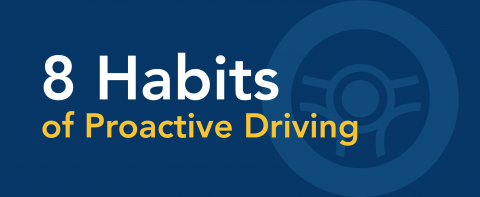
Proactive driving means you are a responsible driver. Whether you’re a brand new operator or you have years of experience, you have to have the ability to read and react to other people on the road in a safe and efficient manner. Here are eight ways you can be a proactive driver on the roads:
- Think Safety First.
By avoiding aggressive and distracted driving tendencies, you put yourself in a stronger position to deal with other people’s unsafe driving. Always lock your doors and wear your seatbelt to protect yourself in the event of a crash.
- Be Aware of Your Surroundings.
Always look around the vehicle for signs, signals, roadway markings, and potential hazards. Check your mirrors and blind spots every 3-5 seconds. Scan conditions 12-15 seconds ahead of you in all environments, 1-1½ blocks in city environments and ¼ mile in highway environments.
- Don’t Depend on Other Drivers.
Do not assume another driver is going to move out of the way or allow you to merge. Have a plan in case you encounter an unsafe or distracted driver.
- Maintain Proper Following Distance.
Follow the 3- to 5-second rule to help you establish and maintain a safe following distance and provide adequate time for you to brake to a stop if necessary. Increase your following distance an additional second for each condition such as rain, snow, fog, nighttime driving, or if you’re following a large truck or motorcycle.
- Follow the Speed Limit.
Posted speed limits apply to ideal driving conditions and higher speeds make controlling your vehicle that much more difficult if things would go wrong. Thus, it’s your responsibility to ensure your speed matches conditions to maintain control of your vehicle.
- Have an Escape Route.
In all driving situations, the best way to avoid potential dangers is to position your vehicle where you have the best chance of seeing and being seen. Also, make sure there’s an alternate path of travel so you have a place to move your car if you’re suddenly blocked or in danger.
- Communicate with Other Drivers.
Use various methods to notify those you share the road with of your intentions. Examples include using directional signals, position of vehicle, headlights, or your horn to communicate with another driver.
- Cut Out Distractions.
A distraction is any activity that diverts your attention away from the road such as texting, eating, applying makeup, or talking to passengers. Driving deserves your full attention so remember to always stay focused on the driving task. Distractions are the #1 cause of crashes!
If you’re interested in sharpening your knowledge and becoming a more proactive driver, contact Top Driver today to sign up for an online driving course.
